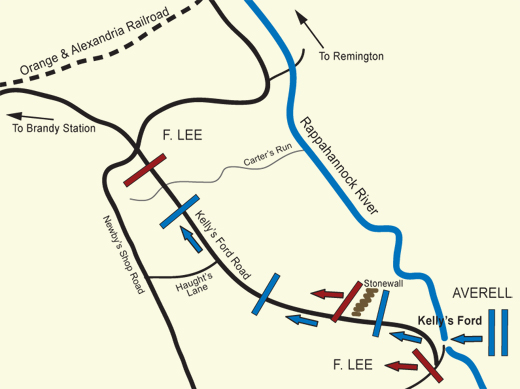Introduction
(Not part of a campaign.) Following the battle of Fredericksburg in December 1862, Union and Confederate armies settled into winter encampments along the Rappahannock River.
General Robert E. Lee’s Confederate infantry encamped near Fredericksburg on the south side of the river. General Ambrose Burnside’s Federals pitched their tents on the north side of the river in Stafford County.
Throughout the winter, Union and Confederate cavalry repeatedly crossed the Rappahannock and raided their enemies on the opposite bank. The largest of these raids occurred on March 17, 1863, and resulted in a pitched battle at nearby Kelly’s Ford, on the Fauquier-Culpeper County border. Kelly’s Ford was the first substantial purely cavalry fight in the eastern theatre of war.
Battle Of Kelly’s Ford
Date: March 17, 1863
Result: Inconclusive
Troops Engaged: 2,100 US; 800 CS
Casualties: 78 US; 133 CS
Ordered to attack General Fitzhugh Lee’s Confederate cavalry near Culpeper, General William Averell and his Federal horsemen crossed the Rappahannock River at Kelly’s Ford on the morning of March 17. After driving back Lee’s skirmishers, Averell took up a defensive position in the woods near the ford, and awaited Lee’s horsemen.
When the Confederates charged, they rode across the Wheatley farm towards a stone wall, in an attempt to turn the Union right flank, but fierce fire forced them to veer left, exposing their flank. It was during this charge that the “Gallant” Major John Pelham fell, mortally wounded. On the Union right, Lee’s men attacked but withdrew when Federal regiments moved to strike their own flanks. Lee withdrew the entire Confederate line, and made one final charge. “It was like the coming together of two mighty railroad trains at full speed. The yelling of men, the clashing of sabers, a few empty saddles, a few wounded and dying, and the charge was over,” wrote one soldier.
As Federal artillery fire began to cut gaps into the Rebel line, they retreated. Averell didn’t press his advantage, however. Fearing he would soon face Confederate reinforcements, Averell withdrew his men back across the Rappahannock. The battle ended in a draw, marking the first time Confederate cavalrymen had not defeated their Union opponents.
KELLY’S FORD TODAY
Today, a bridge spans the Rappahannock River at Kelly’s Ford, about 300 yards upstream from the nineteenth-century crossing. From the pedestrian overlook at the middle, one can see the remains of the mill dam upstream and on the south bank, the dry mill race which served as a rifle pit for Confederate forces.
Below the bridge and adjacent to the boat landing, eight acres of the riverfront where the fighting occurred is preserved by the Brandy Station Foundation, and is accessible via a number of foot trails. Much of the battlefield is on the Culpeper side of the river in the Phelps Wildlife Management Area. The stone wall where Union troops positioned themselves to await Lee’s attack still remains, and a path towards the river leads you to a monument marking the spot of the “Gallant” Major Pelham’s mortal wounding.

